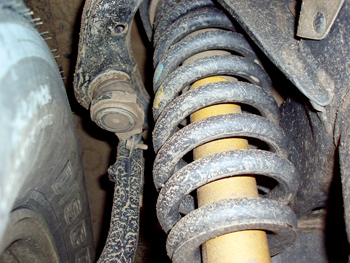
If all roadways were glass-smooth, we wouldn’t need springs and suspension systems in modern vehicles. But, in the real world, roadways have bumps, dips and potholes that can severely damage a vehicle. To smooth out these irregularities in road surfaces, we couple a compressible spring with a flexible suspension system to smooth the ride and increase the driver’s control of the vehicle.
Unfortunately, the elastic strength of the steel in a modern spring diminishes due to high loading and repeated flexing. The most noticeable symptom of spring wear is a sagging suspension system or uneven vehicle ride height. Less common are springs that break due to metal fatigue or to a stress riser caused by corrosion or physical damage on the spring’s surface.
In other cases, springs are replaced to enhance the load-carrying or handling characteristics of a vehicle. A good understanding of how springs are rated and how they operate is indispensable for achieving the anticipated outcomes in spring modifications. With these issues in mind, I’ll cover the basics of how springs operate and how to choose a spring that will enhance vehicle performance.
SPRING RATES
Spring rate is the amount of pressure required to compress the spring one inch. Spring rate on coil springs is most affected by wire diameter, spring diameter and the number of active coils, while spring rate on torsion bars is determined by bar diameter and length. The length, thickness, number and position of the individual spring leaves affect spring rate on leaf springs. Most spring manufacturers supply charts that use these and other factors to mathematically determine the rate of their springs.
COIL SPRINGS
Coil springs are generally rated by free length, compressed length, outside diameter, number of coils and wire size. Most modern import passenger vehicles use coil springs because they’re compact and versatile. Most coil spring rates are linear, which means that spring compression is directly related to load. Coil springs can also be progressively wound, with the coil spacing closer at one end of the spring. This creates a spring rate that progressively increases as the spring is compressed. Progressively wound springs allow a smooth ride, while at the same time providing enough spring capacity to support heavier-than-normal loads. See Photo 1.
TORSION BARS
Modern import trucks generally use lateral bar-type torsion bars on their front suspensions because torsion bars are compact and allow the suspension to be easily adjusted to its correct height. In most cases, a torsion bar breaks when the metal loses its torsional strength. 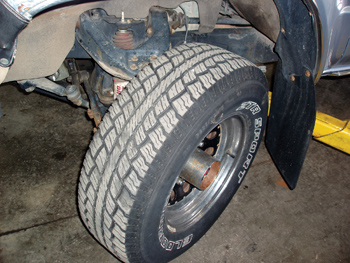 The downside of torsion bars is that they can be built only to a linear rate. When replacing torsion bars, remember that the right- and left-hand torsion bars aren’t interchangeable on many vehicles and, like all springs, should be replaced in matched pairs. See Photo 2.
The downside of torsion bars is that they can be built only to a linear rate. When replacing torsion bars, remember that the right- and left-hand torsion bars aren’t interchangeable on many vehicles and, like all springs, should be replaced in matched pairs. See Photo 2.
LEAF SPRINGS
The unique feature of leaf springs is that they are a progressive-style spring that not only supports the weight of the vehicle, but also attaches the vehicle’s drive axles to its frame. Leaf springs are still used in most truck rear suspensions for this reason. In addition to performing the above functions, the friction created between the spring leaves as they are extended and compressed tends to dampen spring rebound.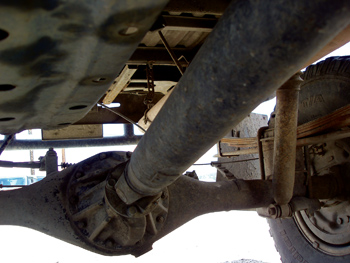
In most modern applications, a leaf spring is built with one or more main leaves that are usually connected to the frame by a fixed mount at the front and a flexible shackle mount at the rear. The pivoting shackle allows the arched main spring leaves to change length as the spring compresses. Additional leaves of varying thickness and length are added to increase the load-bearing capacity of the spring. Short, thick leaves are often installed at the bottom of the spring stack to act as “over-load” springs. All of the leaves are held in position by a center bolt that also locates the spring assembly onto the axle housing spring perch. See Photo 3.
Leaf springs generally fail when one or more leaves break. When the center bolt breaks, the axle assembly will shift in relation to the chassis, which causes the vehicle to “dog-track” while in motion. Worn fixed-mount spring bushings can cause the same dog-tracking symptoms, but to a lesser extent. Because the center bolt is generally located forward of the mathematical center of the top leaves, leaf springs are often installed backward, which will dislocate the axle and cause a similar dog-tracking situation.
When leaf springs wear out, they lose the arch originally built into the springs. Wear in leaf springs can generally be detected by observing the amount of travel left in the rear spring shackle with the vehicle at rest and at normal load. If the rear shackle is fully extended, the spring should be replaced.
SUSPENSION GEOMETRY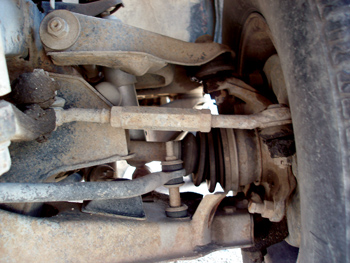
To preserve a geometrically correct relationship among its individual parts, independent suspensions systems are designed to operate at a specified suspension height. Photo 4 shows the tie rod resting at a slight downward pitch with the suspension at normal height. This is the normally correct position for both tie rods and control arms because the suspension can be depressed slightly without seriously changing the angle of the tie rod.
On the other hand, if the suspension height is increased or decreased beyond specifications, the tie rod will no longer maintain a correct geometric relationship with the suspension system. Consequently, modest changes in suspension height will cause extreme changes in toe angle. This phenomenon, known as “bump steer,” will cause the steering system to become over-sensitive to road contour and will cause premature tire wear.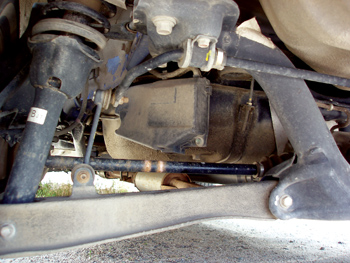
A dramatic change in suspension height will similarly affect independent rear suspensions. Photo 5 illustrates the geometric relationship among the lower control arms, anti-sway bar and rear axle half-shaft. Clearly, this type of suspension is difficult to modify without developing extreme adverse effects on suspension and drivetrain geometry.
PERFORMANCE MODS
Extreme suspension modifications are better left to shops with the experience and tooling needed to make these modifications. As for working with the street performance enthusiast who wants to increase the overall handling or appearance of his vehicle, it’s important to understand some spring performance basics.
For example, it’s important to understand the relationship between the spring, shock absorber and anti-sway bar. In general, stiffer springs require softer shock absorbers, while softer springs require stiffer shock absorbers to maintain rebound control. Similarly, stiffer springs require softer anti-sway bars, while softer springs require stiffer anti-sway bars to keep the vehicle level while cornering.
A vehicle modified for dirt-road driving generally requires softer springs that will better absorb irregularities in the road surface and longer springs to increase suspension travel. These features allow the shock absorber to better control suspension rebound. It goes without saying that shock absorbers used on dirt-road applications need a lot of piston area and oil capacity to better dissipate heat. Sway bar performance should be appropriate to the application. In road-course racing, a stiffer sway bar might be appropriate, whereas off-roading might require maximum suspension travel, in which case the sway bar might be eliminated altogether.
Pavement performance can better utilize stiffer springs because the road surface is smoother and the tires have better adhesion during high-speed cornering. Stiffer springs also allow the vehicle to operate at slightly below specified suspension height without bottoming out. Here again, the shock absorber should be matched to the spring rate. Stiff shocks mated to stiff springs might create a suspension so rigid that the wheel lofts off the pavement, thus decreasing tire adhesion.
In any case, it’s always a more efficient approach to buy a suspension performance package that matches individual components to their intended use. Most performance spring manufacturers have technical help lines that guide technicians and retail customers toward spring packages suited to their individual needs. Whatever the situation, always remember to replace springs in pairs and remember also that springs and correct suspension height go hand-in-hand to create maximum suspension and steering performance.












